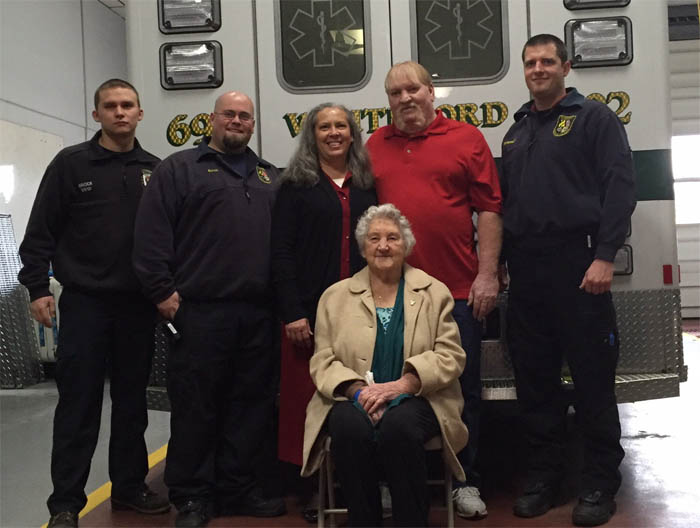
From the Whiteford Volunteer Fire Company:
Whiteford Volunteer Fire Company and EMS Foundation employees were recognized by the Buecker family for a CPR save they had on November 15, 2015. The family presented Whiteford VFC with a donation check, Thank You card to the personnel on the call, and an immense amount of thanks and appreciation for the crew involved in this incident. The original call was for Mrs. Grace Buecker, 93 years old, who had fallen and needed assistance.
On Sunday, November 15, 2015 at about 0025 hours Whiteford Volunteer Fire Company EMS unit was dispatched for fall patient in the 800 block of Federal Hill Rd. Street, MD 21154. At 0027 hours Paramedic 6 with Foundation Paramedic Mark Hagley and A692 with Foundation EMT/Driver Ben Becker & WVFC Brock Flahart called en-route and arrived on location at 0029 hours. The EMS crew was met by the patient’s son, Fredinand Buecker, in the driveway. Mr. Buecker then directed the crew to the residence, when he suddenly collapses in the driveway. The EMS crew immediately assessed Mr. Buecker and found he was in cardiac arrest (no pulse or breathing) and began CPR and advance life measures which included one (1) defibrillation to him. The crew was able to get him into the medic to continue CPR and ALS treatment and call for additional assistance. The family was unaware of the outside situation until a family member went outside to investigate the EMS crew delay. The EMS crew was able re-establish the patient’s breathing and began transport to Upper Chesapeake Medical Center with WVFC FF/Driver Donald Galbreath now driving the medic unit.. While en-route to the hospital, the patient regained consciousness and began talking to the EMS crew asking why he was in the ambulance. Upon arrival at the hospital, Mr. Buecker was fully alert and talking with hospital staff. The original fall patient was transported by Jarrettsville VFC Medic 791 with non-threatening injuries to Upper Chesapeake Medical Center.
From the Harford County Vol Fire/EMS Association:
Emergency Medical Services (EMS) are an ongoing changing and dynamic field. Recently the Maryland Institute for Emergency Medical Services Systems (MIEMSS) has made new protocol updates in victims of cardiac arrest and utilizing high performance CPR.
It is a yearly practice for MIEMSS to update EMS protocols to keep up with the dynamics in the system. This new protocol for EMS providers will allow them to formally pronounce death in the field after 15 minutes of high performance CPR and additional resuscitation efforts.
The high performance CPR or otherwise known to the public as Hands-Only CPR currently is being recommended by the American Heart Association. There is national evidence that if there is to be a successful return of a pulse it will be on the scene of the incident. The quicker that CPR is initiated the greater the chance a patient has of surviving a cardiac arrest. King County Resuscitation Academy in Seattle Washington has done a scientific study that demonstrates when CPR is performed to guidelines, the chances of successful resuscitation increase substantially. Minimal break in compressions, full chest recoil, adequate compression depth, and adequate compressions are all components of CPR that can increase survival from cardiac arrest. Together, these components combine to create high performance CPR.
The American Heart Association advises that “Most people, who experience cardiac arrest at home, work or in the public die because they don’t receive immediate CPR from someone on the scene.” They further advise “If you see a teen or adult suddenly collapse, call 9-1-1 and push hard and fast in the center of the chest to the beat of the classic disco song “Stayin’ Alive.” CPR can more than double a person’s chances of survival, and “Stayin’ Alive” has the right beat for Hands-Only CPR
We know that being in the middle of a medical emergency is a stressful time for people, especially when the patient is in cardiac arrest. The new protocol for the Emergency medical Services is a change not only for the providers but for anyone that has been in the situation of someone going into cardiac arrest in their home or a nursing care facility.
Previously most all patients were transported to the closest appropriate hospital unless they were obviously deceased or other extenuating circumstances were involved. The new protocols for our emergency service providers allows them to do 15 minutes of high performance CPR along with additional resuscitation efforts and if there is no return of a pulse then they can pronounce the patient deceased. This is for the patient that is not obviously deceased. In turn patients will be left at the residence or in the skilled nursing facility and the local police department would then take over the scene.
Of course there are always exclusions that come into play on this protocol. Our emergency medical providers would continue to attempt resuscitation if the cardiac arrest was secondary to hypothermia or submersion in water, the patient is pregnant or the patient has not reached their 18th birthday.
We encourage everyone to take a CPR class and learn the correct techniques for infant, child, and adult CPR. You never know when you will need these skills and it could make a difference in someone’s life. You can learn more and familiarize yourself with these life saving techniques by going to www.Heart.org. Please take the time to visit this site and learn more to possibly help your family, friends, and coworkers.



Leave a Reply
You must be logged in to post a comment.